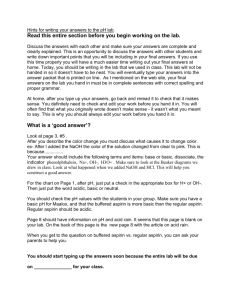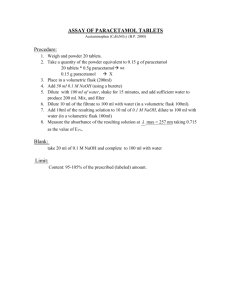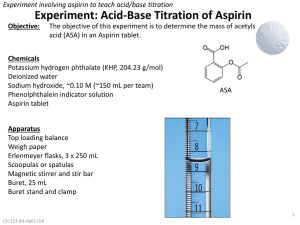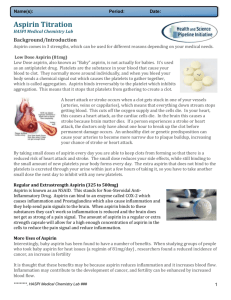Ch. 14 - Liquids
advertisement
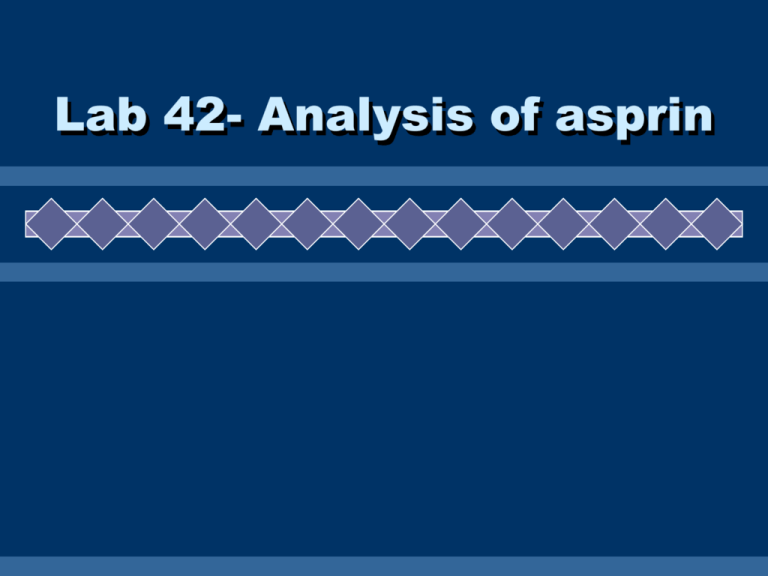
Lab 42- Analysis of asprin Part 1 Neutralize all the asprin, and additonal acidic impurities Part 2 Use excess NaOH to hydrolyze all the asprin Part 3 Use HCL to neutralize extra NaOH to know exactly how many moles of NaOH were used. Many reactions are slow or present unfavorable equilibria for direct titration. Aspirin is a weak acid that also undergoes slow hydrolysis; i.e., each aspirin molecule reacts with two hydroxide ions. To overcome this problem, a known excess amount of base is added to the sample solution and an HCl titration is carried out to determine the amount of unreacted base. This is subtracted from the initial amount of base to find the amount of base that actually reacted with the aspirin and hence the quantity of aspirin in the analyte. A. Sample Preparation Accurately record the weight of a group of three aspirin tablets so that you can determine an average tablet weight. Use a mortar and pestle to crush tablets to produce A. Sample Preparation Using a clean dry weighing bottle, weigh accurately, by difference, triplicate ~0.5 g samples of tablet, into labeled 250 mL Erlenmeyer flasks. To each flask, add 20 mL of ethanol (measure by graduated cylinder) and three drops of phenolphthalein indicator. Swirl gently to dissolve. A. Sample Preparation (Aspirin is not very soluble in water — the ethanol helps the aspirin dissolve. Note that an aspirin tablet contains other compounds in addition to aspirin. Some of these are not very soluble. Your solution will be cloudy due to insoluble components of the tablet.) Aspirin Titration with base Titrate the first aspirin sample with NaOH to the first permanent cloudy pink colour. The aspirin/NaOH acid-base reaction consumes one mole of hydroxide per mole of aspirin. The slow aspirin/NaOH hydrolysis reaction also consumes one mole of hydroxide per mole of aspirin, and so for a complete titration we will need to use a total of twice the amount of NaOH that you have already used, plus we will add some excess NaOH to ensure that we really have reacted with allof the aspirin in your sample (adding excess reactant drives the equilibrium towards products — Le Chatelier’s principle). Calculate how much extra NaOH you will need to add, following this reasoning The volume of base to add for the hydrolysis reaction is equal to the volume of base you have already used to titrate to the acid-base endpoint in the titration plus an additional 10 mL of excess base For example: if you used 26 mL of base in the previous step, the volume of base you would add now would be 26 + 10 = 36 mL. Thus, you would have added a total of 26 + 26 +10 = 62 mL of base.) Use your burette (not a graduated cylinder) to add the appropriate amount of extra NaOH to each of your three sample flasks. (Do not to allow the level of base in the burette to fall below the graduated markings; if necessary, record an intermediate volume and refill the burette to continue with youradditions Record the total volume of NaOH added to each flask within 0.02 mL. Heating the reaction to completion Add two or three boiling chips to each flask and heat in a water bath to speed up the hydrolysis reaction. Avoid boiling, because the sample may decompose. While heating, swirl the flasks occasionally. After 15 minutes, remove samples from the water bath and cool for 5 minutes If the solution is colourless, add a few more drops of phenolphthalein Back titration with acid The only base remaining in each flask will be excess base that has not reacted with the aspirin. Using your burette with your ~0.1 M HCl solution, titrate the excess base in each flask with HCl until thepink colour just disappears. The endpoint is best described as “cloudy white”. Titration Titration standard solution • Analytical method in which a standard solution is used to determine the concentration of an unknown solution. unknown solution B. Titration Equivalence point (endpoint) • Point at which equal amounts of H3O+ and OHhave been added. • Determined by… • indicator color change • dramatic change in pH

